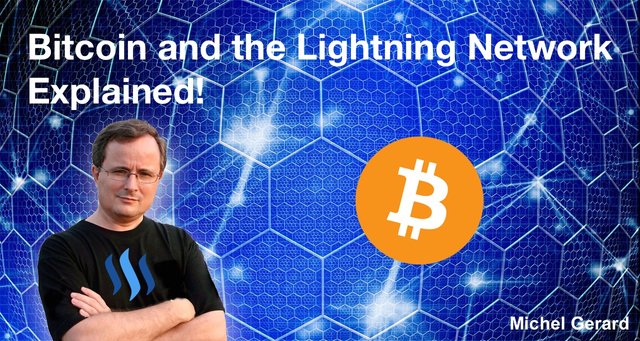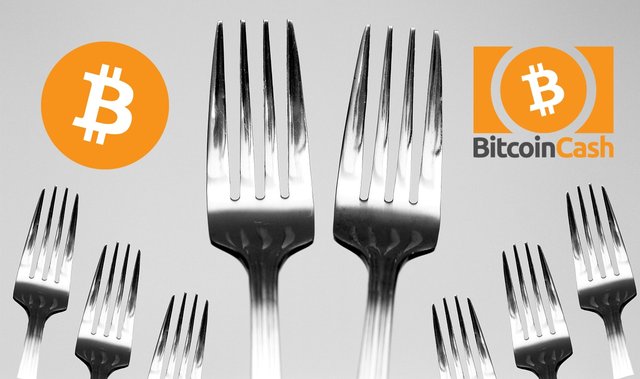Bitcoin and the Lightning Network Explained!
Would you like to learn what Bitcoin is, how the Bitcoin blockchain works with its benefits and issues, and how the lightning network can solve most of Bitcoin's problems because this might be useful for you if you are transacting in cryptocurrency?

Do you know exactly what Bitcoin is and how it works on the blockchain? Having bought or sold Bitcoin yourself, you may be aware of the limitations it has in its current state, but not of the solution that can make it the great cryptocurrency it was supposed to be.
In this post we are going to explain, what Bitcoin is, the blockchain technology, how Bitcoin is used and its challenges to mass adoption, and the Lightning Network.
Bitcoin and the Lightning Network Explained!
Before getting to the Bitcoin Lightning Network, we need to have some background on what Bitcoin is and why we need this new technology to solve Bitcoin's current issues.
What is Bitcoin?
Bitcoin is a digital currency which powers the Bitcoin blockchain and enables fast peer to peer transfer of value (money) without the need of a third-party intermediary like banks. What makes Bitcoin valuable is its limited supply (capped at 21 million) and growing demand across the world. Bitcoin can potentially become a global reserve currency of the future.

Bitcoin transactions are carried out on the Bitcoin blockchain and transactions are validated using a proof-of-work consensus algorithm. Miners (nodes on the network) compete for validating the transactions and in return get mining rewards in the form of Bitcoins. The transactions are secured using cryptography, and that's why it is also called cryptocurrency (Bitcoin being the first such coin in the world).
Blockchain technology
To be part of the network you need to download a protocol (software program) on a node (a device like a mobile or laptop which has a unique IP address). The node must be connected to the Internet. The nodes can send or receive Bitcoins through a platform, which is called a wallet. Each wallet has a private key and a public address.

Some nodes can also act as miners. The records of each transaction carried out on the Bitcoin network are stored in a public ledger. The ledger has blocks, each of size 1 MB. Each block has a unique alphanumeric identifier called a hash. When one block is full, the data is written on the next block, which also includes the hash of the previous block, thus creating a chain of blocks. That's why it is called a blockchain.
Blockchains are immutable, which means once a block is mined nobody can change the data within that block. This feature is what brings transparency and trust. The copy of the blockchain is maintained on each node of the network making it genuinely decentralized (there is no centralized server or database).
Use cases of Bitcoin and challenges to adoption
While Bitcoin was invented primarily for use in transferring value, it has found widespread favor as a store of value.
While theoretically, transactions on the Bitcoin blockchain are meant to be fast with minimal transfer fees (also called mining fees), however, we are still far from the desired state, currently.
The adoption and use of cryptocurrencies for money transfers have been slow owing to many reasons. One, of course, is the slow speed of transactions and very high transaction fee.
During December 2017 low-value transactions were taking many days to go through and a transaction worth $100 of Bitcoin, the fee paid was as high as $25.

This problem in part exists because miners place a higher preference on those transactions which are ready to pay a higher mining fee.
So, low-value transactions have to wait in the queue to be mined. Mass adoption will lead to more transactions, and that would slow down the network further. However, many solutions are being worked upon to address the scalability issue.
It gave an opportunity to a part of the community which had been lobbying for increasing the block size to argue that Bitcoin in its current avatar was not serving the purpose for which it was invented.
The Bitcoin purists, on the contrary, believed that increasing the block size was only a temporary solution and eventually the same problem would be confronted again.
Failing to arrive at a consensus is what led to the forking of the Bitcoin blockchain last year, and the Bitcoin Cash blockchain (the block size was hardcoded and made to 8 MB) was created.

The core team, on the contrary, went ahead and implemented a solution called Segregated Witness (SegWit).
In SegWit unimportant data instead of being stored in the main block is stored on sidechains, thereby releasing more space in the blocks, which can accommodate more records.
The solution: Lightning Network
The lightning network is a solution being proposed to settle the issue of scalability. It was proposed in 2015 by Thaddeus Dryja and Joseph Poon. The thought process behind the solution is that not all transactions need to be recorded on the Bitcoin blockchain.
The lightning network provides another transactional layer on top of the blockchain consisting of multiple payment channels.

Two entities who wish to transact multiple times can do so by opening a payment channel between them. Only the opening of the channel is recorded on the blockchain. The two parties can continue to transact between them facilitated by the lightning network, and when they wish to close the channel, then the complete history would be written onto the blockchain.
The payment channel-based transactions don’t need to be broadcast to the entire network (making them fast) and don't need to be mined (no fee or a meager fee).
What helps to implement the payment channels are multi-signature wallets. These wallets need more than one signature to initiate a transaction. Two entities wishing to transact with each other would open a multi-sig wallet, and both would deposit some Bitcoins into it. The address of the wallet is recorded onto the blockchain with the initial amount.

Now the parties can carry out as many transactions as they wish, and the records are stored on the lightning network ledger (signed off by both sides after each transaction to maintain how much each owns). Once the entities wish to close the payment channel, the balance is recorded onto the primary blockchain.
Benefits of the lightning network
- Instant Payments: Ultra-fast transactions are enabled without having to wait for the mining of blocks (which take close to 10 minutes on the primary network). Smart contracts are used to ensure security without the need to create an on-chain transaction for individual payment records.
- Scalability: Billions of transactions per second are enabled across the network. Also, facilitates instant micropayments.
- Low fee: Minimally low fee because transactions are settled off-chain.
- Cross-chain Atomic Swaps: Cross blockchain atomic swaps are possible if the participating blockchains use the same hashing function.
The current state of implementation
In March 2018, Lightning Labs released the beta version for developers to test on the Bitcoin main net. Since then the lightning network has been growing steadily -– with the nodes going up from 1,500 to 3,000 and the payment channel up from 4,000 to 11,000. The lightning network capacity has hit the 100 Bitcoin mark, up from 50 in July this year.

In May 2018, Vaultoro.com started accepting lightning network payments, and in July Coingate, a payment processor, launched a service for merchants to accept payments through lightning networks.
With the scalability debate addressed by the lightning network, mass adoption of Bitcoin as a payment method is not far. Governments and central banks across the world need to appreciate the merits of using cryptocurrencies for payments and must provide regulatory recognition to this new universal cryptocurrency.
Would you upvote this post and follow me for more because this will encourage me to write more posts like this one?
I have categorized my posts on Steemit for easy access:
Steemit tools | Steemit strategies | Steem economics | Steem on WordPress | Blogging on Steemit | Steemit posts I curated | Cryptocurrency | Cryptocurrency trading | Mac computer tutorials | WordPress & online marketing | Self-development & motivation | Travel in Thailand | Travel in Japan | Travel in Europe | Life in Thailand | Fitness challenge | Fruit-veggie juices & smoothies | Education | My answers on Quora | Fundition tutorials & projects | Miscellaneous writing
You may prefer to go to my Steemit Posts Directory.
Want to learn a new skill? Visit MG Course Discounts where I have lots of online courses you can take for only $9. Sign-up for the newsletter to get one free course and coupon codes.
Want to learn about Bitcoin and Blockchain technology? Click here for free ebook.
Would you like to learn how to trade Bitcoin and cryptocurrency with daily profits and grow your money with a simple, but effective strategy, because this beginner-friendly crypto trading course, that I am taking myself, might be your opportunity to finally be a winner in crypto?
You might want to read this post: My First Impression of the "5 Trades Money Machine!"
The most important votes you can make on Steem are for Witnesses. The top 20 witnesses can influence the addition or removal of features in future Steem hard forks. Read my post: What is a Steem Witness, How to Vote and Why?
Michel Gerard
Great overview Michel. The lightning network is crucial for bitcoin to keep expanding. It is a shame it gets so little publicity.
Thank you @rhyscn for your feedback. I wrote the post because I wanted to learn more about it myself and I am glad this will be useful for others.